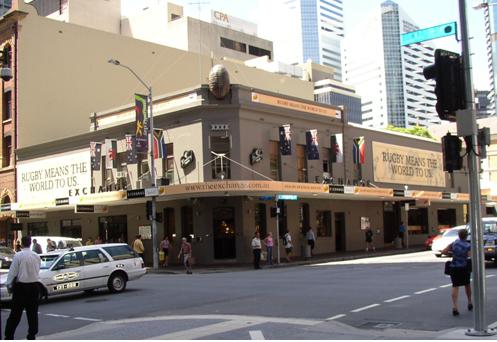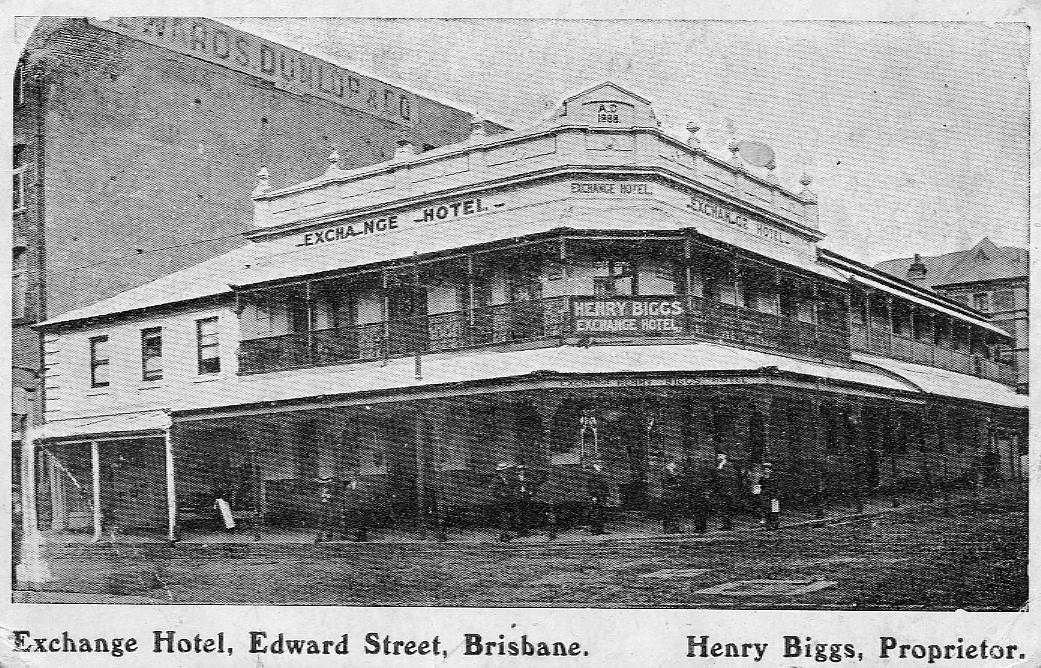Addresses
Type of place
Hotel (pub)
Period
Victorian 1860-1890
Style
Free Classical
Addresses
Type of place
Hotel (pub)
Period
Victorian 1860-1890
Style
Free Classical
The Exchange Hotel, constructed in 1863, is one of the oldest surviving hotels in Brisbane’s CBD. The hotel has undergone a number of alterations since the 1880s, including the removal of its verandahs, but nonetheless retains the principal characteristics of a nineteenth century hotel, including its prominent corner position.
Also known as
Stock Exchange Hotel
Lot plan
L1_B12348
Key dates
Local Heritage Place Since —
Date of Citation —
Construction
Walls: MasonryPeople/associations
John Ibler - 1887 additions (Architect)Criterion for listing
(A) Historical; (D) RepresentativeInteractive mapping
Also known as
Stock Exchange Hotel
Lot plan
L1_B12348
Key dates
Local Heritage Place Since —
Date of Citation —
Construction
Walls: MasonryPeople/associations
John Ibler - 1887 additions (Architect)Criterion for listing
(A) Historical; (D) RepresentativeInteractive mapping
History
The Exchange Hotel is located on the corner of Edward and Charlotte Streets. Peter Hartley first purchased the land in 1850 and the hotel was constructed in 1863, during Hartley’s period of ownership. Like many other hotels in Brisbane, the Exchange Hotel was built on a street corner. This ensured these hotels became familiar landmarks by which a particular intersection might easily be identified. The Exchange Hotel was also built during Brisbane’s first significant building boom, which took place in the early 1860s. According to Gordon Greenwood, “The optimism of the early sixties produced a building boom which led to a rapid increase in the number of residences, shops and public buildings”.1
The first advertisement for this hotel drew attention to the superior accommodation for gentlemen and families, good stables and proximity to the A.S.N. Wharves located at the Town Reach of the river. These characteristics reflected the purpose of hotels in Brisbane during the nineteenth century. According to Morrison, writing in the 1880s:
Few cities afford such a variety of hostelry accommodation as the City of Brisbane. The shifting character of the population, and the enormous opportunities for speculation have created a large demand for temporary homes.1
Hotels thus played an intrinsic role in the development of Brisbane, particularly given the significance of land speculation in the city’s history. This is reinforced by the construction of this hotel during a property boom, when the need for temporary accommodation was acute.
The Exchange Hotel was situated in the locality known as ‘Frogs Hollow’, an area bounded by Alice, George, Elizabeth and Edward Streets. For much of the nineteenth century, this section of the city was known as Frogs Hollow because it was a low-lying, marshy area prone to flooding.
In this period the area was largely filled with residential properties, boarding houses, various small businesses and the odd warehouse or factory. All of these were adjacent to the city’s increasingly busy wharves, a ferry terminal and the Botanic Gardens. It was a place that teemed with life both day and night and would have also ensured a strong trade for local hotels, along with accommodation.
The Exchange Hotel was remodelled in 1887 during another period of an economic and building boom in Brisbane, which occurred throughout most of the 1880s. During this period a large number of Brisbane hotels were built or extended and redeveloped, primarily to accommodate the dramatic increase of Brisbane’s population, which almost trebled during the decade. Architect John Ibler invited tenders for alterations and additions to the Hotel in early June 1887. Ibler was born in Bavaria, Germany, and practiced as an architect in Victoria before moving to Brisbane in 1886. It is unclear what ‘alterations and additions’ were carried out but it is likely that the Hotel was extended along the Edward and Charlotte Street frontages, amongst other changes. The current shape of the building was therefore fixed in this period.
The location of the Exchange in Frogs Hollow also illustrates the other primary purpose of hotels in Brisbane’s history, that is, as places for social gatherings. In particular, according to Ronald Lawson, by the 1890s Brisbane’s hotels functioned as working men’s clubs: “the vast majority of hotel patrons were workingmen: there was a strong lower-class taint associated with drinking in hotels”.1 This was the case in a hotel’s ‘public bar’ as opposed to the ‘private bar’, which was only available to guests staying at the hotel. From the 1880s onward, Frogs Hollow was increasingly filled with warehouses and light industry and the proximity of the Hotel to such businesses would have ensured a strong trade from working men.
The significance of hotels providing accommodation continued past the nineteenth century. An advertisement for the Exchange Hotel in the Brisbane newspaper the Sun, in 1912, draws attention to the fact that the hotel is a:
First-class Home for Visitors of Moderate Means. Centrally situated in the very heart of the City. Convenient to all the Theatres – midway between Principal Wharves and Central Railway Station, and within two Minutes of Botanical Gardens.1
Thus the purpose of the nineteenth century hotel as temporary accommodation remained more or less the same into the early twentieth century. This advertisement further reinforces the element of travel that brought guests to the hotel; in this case the wharves and rail. It also suggests that the Hotel benefited from being close to such Brisbane attractions as the theatres and the Botanic Gardens and therefore drew business from the early tourist trade.
The working class aspect of hotel patronage also extended well beyond the nineteenth century. In particular, Australian Labor Party (ALP) staff and politicians frequented the Exchange Hotel from the early 1950s through to the early 1970s. The ALP’s state headquarters was located in Invicta House, on the corner of Elizabeth and Edward Streets, from 1958 to 1972, and its leaders and senior members regularly patronised the Exchange Hotel. The importance of the Exchange Hotel to the ALP, during this period is best summed up by the following 1972 quote from the Brisbane newspaper The Sunday Sun: “Some of the most important political decisions in Labor Party history have been discussed and made over its bars”.1
The Hotel underwent a number of renovations in the 1950s and 1960s, and this is possibly when the verandahs were removed. However, the pressure of commercial development on CBD corner sites, the change in drinking habits caused by the state government’s drink driving campaigns and the spread of off-licence beer, wine and spirits shops throughout Brisbane’s suburbs have all contributed to the demise of hotels in the CBD. Of the thirty-two hotel sites identified within the Central Business District in 1951, only seven remain, including the Exchange Hotel. Nonetheless, a new generation of patrons have ensured the popularity of the ‘pub’. This is reflected in extensive renovations to the Hotel, which were carried out in 2002, converting the Exchange into a modern entertainment venue.
J. M. Freeland has argued that “The pub is one of the most socially significant, historically valued, architecturally interesting and colourful features of Australian Society…[it] has never been a mere transplant and adaptation of an English progenitor”.1 The Exchange Hotel provides evidence of these attributes. It is also one of the oldest remaining hotels in the CBD. The Exchange represents an important visual reminder of the prominence of the hotel in the history of Brisbane and, in particular, the CBD.
Description
This is a very early hotel in a prominent corner in the heart of the city. It relates physically and historically to the Victory Hotel, a similar structure on the one of the opposite corners of Edward and Charlotte Streets. Ongoing changes and refurbishments are characteristic of most hotels as their use evolves with the trends of the times. This early two-storey corner hotel is no exception.
Architect John Ibler designed additions to the hotel in early June 1887; these probably included the decorative pediment, and may have included an extension along the Charlotte Street frontage. A later suspended awning covers the Edward and Charlotte Street footpaths. Further renovations were carried out in 2002.
The original hotel, a two-storey building with a typical chamfered corner and parapet, notwithstanding the ongoing renovations, maintains the integrity and general form of its original street frontages.
Statement of significance
Relevant assessment criteria
This is a place of local heritage significance and meets one or more of the local heritage criteria under the Heritage planning scheme policy of the Brisbane City Plan 2014. It is significant because:
Supporting images

Unidentified photographer,
‘Exchange Hotel - Edward Street - Brisbane’, 6 January 1908,
Brisbane City Council Library Services, Brisbane City Council
References
-
Brisbane History Group, Brisbane By 1888: The Public Image, Brisbane, Brisbane History Group, 1987, p. 198
-
Ronald Lawson, Brisbane in the 1890s: a study of an Australian urban society, Brisbane, University of Queensland Press, 1987, p.236.
-
The Sun, 25 February, 1912, n.p.
-
“Exchange will be lonely without the ALP”, The Sunday Sun, 16/7/1972, p 20. (for whole of paragraph)
-
J. M. Freeland, The Australian Pub, Melbourne, Sun Books, 1977, p. 1.
-
Brisbane City Council, Properties on the Web, website, post-1946 building cards
-
Brisbane City Council, 1946 aerial photographs.
-
Brisbane City Council, Sewerage Map 1913
-
Brisbane History Group, Brisbane By 1888: The Public Image, Brisbane, Brisbane History Group, 1987
-
Department of Natural Resources, Queensland Certificates of Title and other records
-
Donnelly, J.J. Hotels of Brisbane, B. Arch thesis, University of Queensland, 1967
-
Freeland, J. M., The Australian Pub, Melbourne, Sun Books, 1977
-
Geenwood, Gordon, Brisbane 1859-1959: A History of Local Government, Parramatta, The Cumberland Press, 1959
-
John Oxley Library, photographic collection.
-
John Oxley Library, newspaper clippings files
-
Lawson, Ronald 1973, Brisbane in the 1890s: A Study of an Australian Urban Society, University of Queensland Press, St. Lucia
-
Mahlstedt & Son, City of Brisbane Detail Fire Survey, Map No. 19, 1951
-
National Trust of Queensland, Sailing Days Heritage Walk, Heritage Week 1986
-
Queensland Post Office Directories, 1868-1949
-
The Sun, 1912.
-
The Sunday Sun, 1972
Citation prepared by — Brisbane City Council (page revised September 2020)


